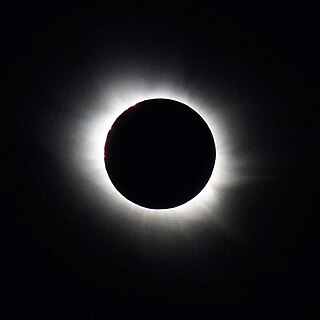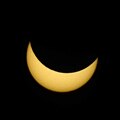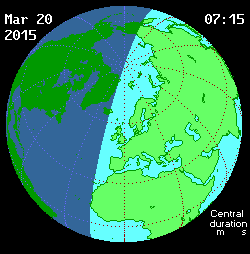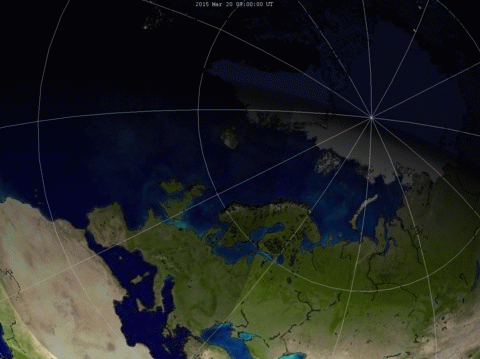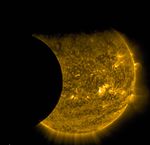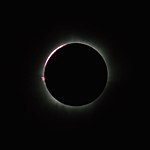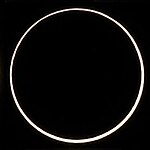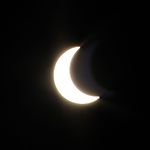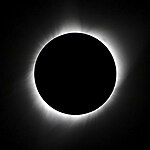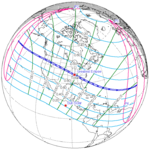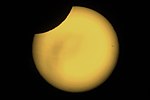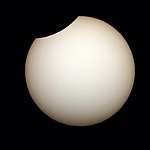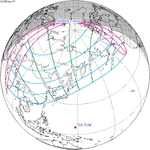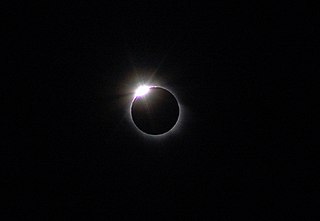
A total solar eclipse occurred on March 29, 2006. A solar eclipse occurs when the Moon passes between Earth and the Sun, thereby totally or partly obscuring the image of the Sun for a viewer on Earth. A total solar eclipse occurs when the Moon's apparent diameter is larger than the Sun's, blocking all direct sunlight, turning day into darkness. Totality occurs in a narrow path across Earth's surface, with the partial solar eclipse visible over a surrounding region thousands of kilometres wide. It was visible from a narrow corridor which traversed half the Earth. The magnitude, that is, the ratio between the apparent sizes of the Moon and that of the Sun, was 1.052, and it was part of Saros 139.

A total solar eclipse occurred on 11 August 1999 with an eclipse magnitude of 1.0286. A solar eclipse occurs when the moon passes between earth and the sun, thereby totally or partly obscuring the image of the sun for a viewer on earth. A total solar eclipse occurs when the moon's apparent diameter is larger than the sun's, blocking all direct sunlight, turning day into darkness. Totality occurs in a narrow path across earth's surface, with the partial solar eclipse visible over a surrounding region thousands of kilometres wide. The path of the moon's shadow began in the Atlantic Ocean and, before noon, was traversing the southern United Kingdom, northern France, Belgium, Luxembourg, southern Germany, Austria, Slovenia, Croatia, Hungary, and northern FR Yugoslavia (Vojvodina). The eclipse's maximum was at 11:03 UTC at 45.1°N 24.3°E in Romania ; and it continued across Bulgaria, the Black Sea, Turkey, the northeastern tip of Syria, northern Iraq, Iran, southern Pakistan and Srikakulam in India and ended in the Bay of Bengal.

A total solar eclipse took place on Sunday, November 23, 2003, with a magnitude of 1.0379. A solar eclipse occurs when the Moon passes between Earth and the Sun, thereby totally or partly obscuring the image of the Sun for a viewer on Earth. A total solar eclipse occurs when the Moon's apparent diameter is larger than the Sun's, blocking all direct sunlight, turning day into darkness. Totality occurs in a narrow path across Earth's surface, with the partial solar eclipse visible over a surrounding region thousands of kilometres wide. It was visible from a corridor in the Antarctic region. A partial eclipse was seen from the much broader path of the Moon's penumbra, including the southern tip of South America and most of Australia.

A total solar eclipse took place on June 21, 2001, with a magnitude of 1.0495. It was the first solar eclipse of the 21st century. A solar eclipse occurs when the Moon passes between Earth and the Sun, thereby totally or partly obscuring the image of the Sun for a viewer on Earth. A total solar eclipse occurs when the Moon's apparent diameter is larger than the Sun's, blocking all direct sunlight, turning day into darkness. Totality occurs in a narrow path across Earth's surface, with the partial solar eclipse visible over a surrounding region thousands of kilometres wide. Occurring 2.2 days before perigee, the Moon's apparent diameter was larger.

A partial lunar eclipse took place on 16 August 2008, the second of two lunar eclipses in 2008, with the first being a total eclipse on 20 February 2008. The next lunar eclipse was a penumbral eclipse occurring on 9 February 2009, while the next total lunar eclipse occurred on 21 December 2010.

A total lunar eclipse occurred from 5:27 to 11:06 UTC on 21 December 2010, coinciding with the date of the Winter solstice in the Northern Hemisphere and Summer solstice in the Southern Hemisphere. It was visible in its entirety as a total lunar eclipse in North and South America, Iceland, Ireland, Britain and northern Scandinavia.
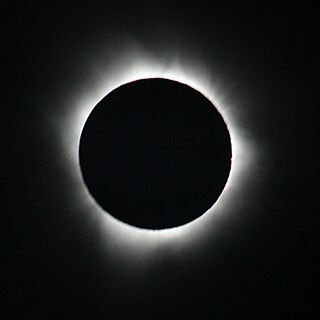
The total solar eclipse of July 11, 2010 occurred over the southern Pacific Ocean. A solar eclipse occurs when the Moon passes between Earth and the Sun, thereby totally or partly obscuring the image of the Sun for a viewer on Earth. A total solar eclipse occurs when the Moon's apparent diameter is larger than the Sun's, blocking all direct sunlight, turning day into darkness. Totality occurs in a narrow path across Earth's surface, with the partial solar eclipse visible over a surrounding region thousands of kilometres wide.

A total solar eclipse occurred at the Moon's descending node of the orbit on August 1, 2008. A solar eclipse occurs when the Moon passes between Earth and the Sun, thereby totally or partly obscuring the image of the Sun for a viewer on Earth. A total solar eclipse occurs when the Moon's apparent diameter is larger than the Sun's, blocking all direct sunlight, turning day into darkness. Totality occurs in a narrow path across Earth's surface, with the partial solar eclipse visible over a surrounding region thousands of kilometres wide. It had a magnitude of 1.0394 that was visible from a narrow corridor through northern Canada (Nunavut), Greenland, central Russia, eastern Kazakhstan, western Mongolia and China. Visible north of the Arctic Circle, it belonged to the so-called midnight sun eclipses. The largest city in its path was Novosibirsk in Russia. The eclipse happened only 2+1⁄2 days after the perigee that occurred on July 29, 2008, and the Moon's apparent diameter was larger than average.

A total lunar eclipse took place on 4 April 2015. It is the former of two total lunar eclipses in 2015, and the third in a tetrad. Other eclipses in the tetrad are those of 15 April 2014, 8 October 2014, and 28 September 2015.

A total lunar eclipse occurred on 31 January 2018. The Moon was near its perigee on 30 January and as such may be described as a "supermoon", when the Moon's distance from the Earth is less than 360,000 km. The previous supermoon lunar eclipse was in September 2015.
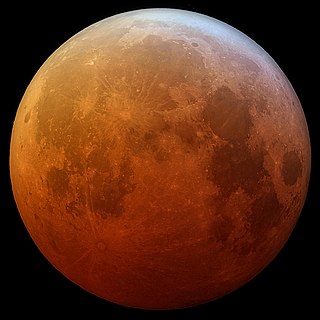
A total lunar eclipse occurred on 21 January 2019 UTC. For observers in the Americas, the eclipse took place between the evening of Sunday, 20 January and the early morning hours of Monday, 21 January. For observers in Europe and Africa, the eclipse occurred during the morning of 21 January. The Moon was near its perigee on 21 January and as such can be described as a "supermoon".
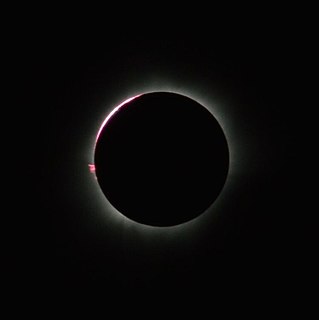
A total solar eclipse took place at the Moon's descending node of the orbit on March 8–9, 2016. If viewed from east of the International Date Line, the eclipse took place on March 8 (Tuesday) and elsewhere on March 9 (Wednesday). A total solar eclipse occurs when the Moon's apparent diameter is larger than the Sun's and the apparent path of the Sun and Moon intersect, blocking all direct sunlight and turning daylight into darkness; the Sun appears to be black with a halo around it. Totality occurs in a narrow path across Earth's surface, with the partial solar eclipse visible over a surrounding region thousands of kilometres wide. The eclipse of March 8–9, 2016 had a magnitude of 1.0450 visible across an area of Pacific Ocean, which started in the Indian Ocean, and ended in the northern Pacific Ocean.
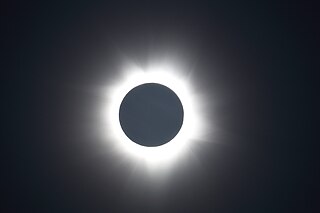
A total solar eclipse took place on 13–14 November 2012 (UTC). Because it crossed the International Date Line it began in local time on November 14 west of the date line over northern Australia, and ended in local time on November 13 east of the date line near the west coast of South America. Its greatest magnitude was 1.0500, occurring only 12 hours before perigee, with greatest eclipse totality lasting just over four minutes. A solar eclipse occurs when the Moon passes between Earth and the Sun, thereby totally or partly obscuring the image of the Sun for a viewer on Earth. A total solar eclipse occurs when the Moon's apparent diameter is larger than the Sun's, blocking all direct sunlight, turning day into darkness. Totality occurs in a narrow path across Earth's surface, with the partial solar eclipse visible over a surrounding region thousands of kilometres wide.

A total solar eclipse occurred at the ascending node of the Moon's orbit on Tuesday, July 2, 2019, with an eclipse magnitude of 1.0459. Totality was visible from the southern Pacific Ocean east of New Zealand to the Coquimbo Region in Chile and Central Argentina at sunset, with the maximum of 4 minutes 33 seconds visible from the Pacific Ocean. The Moon was only 2.4 days before perigee, making it fairly large.

An annular solar eclipse took place at the Moon's descending node of the orbit on May 9–10 (UTC), 2013, with a magnitude of 0.9544. A solar eclipse occurs when the Moon passes between Earth and the Sun, thereby totally or partly obscuring the image of the Sun for a viewer on Earth. An annular solar eclipse occurs when the Moon's apparent diameter is smaller than the Sun's, blocking most of the Sun's light and causing the Sun to look like an annulus (ring). An annular eclipse appears as a partial eclipse over a region of the Earth thousands of kilometres wide.

A total solar eclipse occurred at the Moon's ascending node on 3 November 2013. It was a hybrid eclipse of the Sun with a magnitude of 1.0159, with a small portion over the western Atlantic Ocean at sunrise as an annular eclipse, and the rest of the path as a narrow total solar eclipse. A solar eclipse occurs when the Moon passes between Earth and the Sun, thereby totally or partly obscuring the image of the Sun for a viewer on Earth. A hybrid solar eclipse occurs when the Moon's apparent diameter is smaller than the Sun's in sunrise and sunset, but at Greatest Eclipse the Moon's apparent diameter is larger than the Sun's.
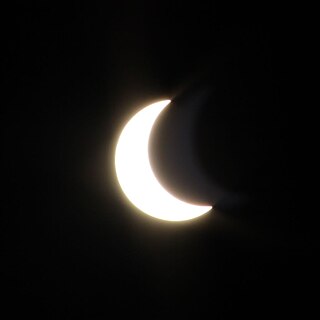
An annular solar eclipse took place on February 26, 2017. A solar eclipse occurs when the Moon passes between Earth and the Sun, thereby totally or partly obscuring the image of the Sun for a viewer on Earth. An annular solar eclipse occurs when the Moon's apparent diameter is smaller than the Sun's, blocking most of the Sun's light and causing the Sun to look like an annulus (ring). An annular eclipse appears as a partial eclipse over a region of the Earth thousands of kilometres wide. Occurring only 4.7 days before perigee, the Moon's apparent diameter was larger. The moon's apparent diameter was just over 0.7% smaller than the Sun's.
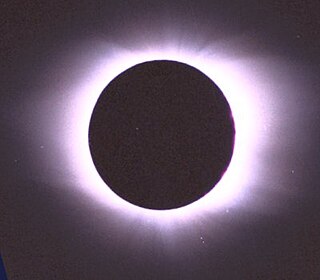
A total solar eclipse occurred at the Moon’s descending node of the orbit on Thursday, February 26, 1998. A solar eclipse occurs when the Moon passes between Earth and the Sun, thereby totally or partly obscuring the image of the Sun for a viewer on Earth. A total solar eclipse occurs when the Moon's apparent diameter is larger than the Sun's, blocking all direct sunlight, turning day into darkness. Totality occurs in a narrow path across Earth's surface, with the partial solar eclipse visible over a surrounding region thousands of kilometres wide. Totality was visible in the Galápagos Islands, Panama, Colombia, the Paraguaná Peninsula in northwestern Venezuela, all of Aruba, most of Curaçao and the northwestern tip of Bonaire, all of Montserrat, Guadeloupe and Antigua and Barbuda.
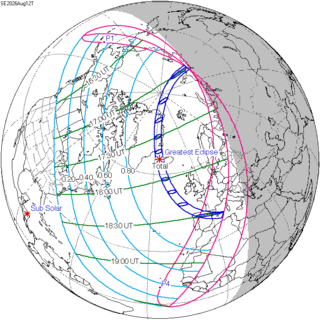
A total solar eclipse will occur at the Moon's descending node of the orbit on Wednesday, August 12, 2026, two days past perigee, in parts of North America and almost all of Europe. The total eclipse will pass over the Arctic, Greenland, Iceland, Atlantic Ocean and northern Spain. The points of greatest duration and greatest eclipse will be just 45 km (28 mi) off the western coast of Iceland by 65°10.3' N and 25°12.3' W, where the totality will last 2m 18.21s. It will be the first total solar eclipse visible in Iceland since June 30, 1954, also Solar Saros series 126, and the only one to occur in the 21st century as the next one visible over Iceland will be in 2196. As lunar perigee will occur on August 10, 2026, two days before the total solar eclipse, the Moon's apparent diameter will be larger.

A total solar eclipse will occur on Monday, May 1, 2079, with a maximum eclipse at 10:48:25.6 UTC. A solar eclipse occurs when the Moon passes between Earth and the Sun, thereby totally or partly obscuring the image of the Sun for a viewer on Earth. A total solar eclipse occurs when the Moon's apparent diameter is larger than the Sun's, blocking all direct sunlight, turning day into darkness. Totality occurs in a narrow path across Earth's surface, with the partial solar eclipse visible over a surrounding region thousands of kilometres wide. The eclipse will be visible in Greenland, parts of eastern Canada and parts of the northeastern United States.
